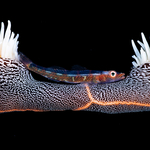Guadalupe diving – What to expect
Gin-clear waters and abundant sharks have put Guadalupe firmly on the map as the world’s best place to go cage diving with sharks. This remote island frequently features on Discovery Channel’s Shark Week and offers an unrivalled white shark diving experience.
Over 320 individual great white sharks have been identified at Guadalupe so far and many of them interact with the diving boats. As most Guadalupe liveaboard operators have an open deck policy, you can enjoy hours in the surface cage during your trip.
Qualified scuba divers can also dive in submersible cages at Guadalupe, allowing you to encounter great white sharks as they cruise around their natural environment at depth.
These intelligent animals are full of personality and a highlight of any Guadalupe trip is learning about the individual sharks and their unique behaviors.
Whether you are in the water or watching from on the deck, there is always something to enjoy.
LEARN ALL ABOUT SHARKS – JOIN SSI’S SHARK ECOLOGY PROGRAM.
Cage diving with sharks – Your questions answered
Where is Guadalupe Island?
Guadalupe Island is a volcanic island sitting 241 kilometers (150 miles) off the west coast of Mexico’s Baja California peninsula. It is the world’s premier destination for cage diving with great white sharks and offers incredible dive conditions.
How do you get to Guadalupe?
Joining a liveaboard safari is the only way you can go diving at Guadalupe Island. Most Guadalupe liveaboard operators meet their guests at San Diego and transfer them to Ensenada to board their vessels. The crossing to Guadalupe takes around 24 hours.
Can anyone go cage diving with sharks at Guadalupe?
Yes! You do not need to be a certified diver to go cage diving with sharks at Guadalupe. Surface cages are open for divers and non-divers, and there are submersible cages for certified divers to enjoy.
Is cage diving bad for sharks?
People have raised concerns that using chum and bait affect the natural behaviors of sharks, and the ecology of the surrounding area. Also, that cage diving causes sharks to associate humans with food.
Cage diving can be bad for sharks if it is conducted inappropriately and without concern for the welfare of the sharks, divers and environment. For example, if an operator uses large amounts of chum and bait, or if they handle the bait poorly and cause sharks to bump into the cage.
All of which can be prevented by following cage diving best practices. Doing so can turn cage diving into a valuable education and conservation tool that helps protect these increasingly rare sharks.
Many of the liveaboards at Guadalupe support shark research and conservation, and all are required to follow a cage diving Code of Conduct. This helps ensure the sustainability and conservation of the Guadalupe Island Biosphere Reserve and its sharks.
Can you swim with sharks without a cage?
You cannot swim with great white sharks without a cage anywhere in the world, and there are no operators that offer that activity. But you can swim with other sharks without a cage at numerous destinations worldwide. Discover 14 of the world’s best places to swim with sharks at the end of this page.
READ MORE: LOVE SHARK DIVING? VISIT SOUTH AFRICA’S WESTERN CAPE.
Guadalupe diving – Essential info to plan your trip.
The best time to visit.
Guadalupe liveaboards operate from July to December, and the peak season is July to November. The best time to go diving with sharks at Guadalupe depends on which sharks you want to see:
Boisterous, energetic male sharks arrive in July and August.
September provides a great mix of male and female sharks.
Huge female sharks arrive in October and November.
Water temperature.
Unlike other cage diving destinations, the water at Guadalupe is relatively warm and you can spend plenty of time in the cage without getting cold.
Water temperature 19 to 22 °C (66 – 71 °F).
Water visibility.
The bright blue waters at Guadalupe offer excellent water visibility, making it is easy to watch sharks approach from a distance and capture stunning shark images.
Water visibility ranges from 42 to 50 meters (125 – 150 feet).
Guadalupe dive conditions.
Guadalupe Island provides sheltered and calm dive conditions. The crossing from the mainland to Guadalupe can be rough though, so remember to pack motion sickness medication if you are prone to getting seasick.
READ MORE: MEXICO’S BEST DIVING PART 1 – THE SOCORRO ISLANDS.
Guadalupe liveaboard safaris.
Most Guadalupe safaris are 5 nights long and include 3 full days of cage diving, with around 10 to 15 hours of in-water time.
Extend your adventure – Guadalupe add-ons.
Some liveaboard operators offer 16 day safaris that combine Guadalupe shark diving with Socorro diving. The Socorro Islands, a remote UNESCO World Heritage Site, are renowned for their abundant marine megafauna and offer world-class diving with whales, sharks and giant Pacific manta rays.
Another option is to combine your Guadalupe safari with diving the Sea of Cortez. This unique area was once described as the ‘aquarium of the world’ by Jacques Cousteau and offers spectacular coral reef diving.
As well as coral reefs, the Sea of Cortez offers diving with sea lions, tens of thousands of mobula rays, and the famous grey whales of San Ignacio lagoon.
CLICK HERE TO EXPLORE TOP DIVE SITES IN THE SEA OF CORTEZ.
TOP TIPS FOR CAGE DIVING WITH SHARKS.
Cage diving at Guadalupe is easy, but these top tips will help you maximize every moment in the water:
Take a thicker wetsuit than usual, along with a hood and gloves.
You do not move much when cage diving and can get colder more quickly than you do during regular dives. Keep warm to make the most of your dive time.
Pack a woolly hat and windproof jacket.
You are unlikely to get cold hanging out in the sunshine at Guadalupe, but a hat and windproof jacket will keep you warm between dives if needed. They are also easy to remove quickly when the sharks turn up and it is time to hop in the cage.
Keep your hands and camera away from the cage edges.
It is important to keep your hands and equipment away from the cage edges – and that is not just to avoid curious sharks! Take care when entering and exiting the cage so that fingers and equipment do not get trapped or damaged.
Eat well and stay hydrated.
Eating well will help you stay warm in the cage and make the most of every minute with the sharks. Eating small amounts of plain food can also help prevent motion sickness in the cage.
Ask about the different cage diving options.
Surface cage diving can be conducted using a snorkel, a dive hookah, or by using simple breath-old techniques. Find out what your options are beforehand, so you can choose a set-up that you are comfortable with. It is a great way to reduce any cage diving nerves.
Spend time on top deck with the crew.
No two white sharks are the same and top deck is one of the best places to learn about their differences. The expansive overheard views make it easy to observe shark interactions, find out which sharks are more dominant, and learn about their unique personalities with the crew.
Pack a good book and a laptop.
The crossing to Guadalupe Island takes around 24 hours. If you are feeling motion sick, you are likely to spend a lot of time lying down in your cabin. The liveaboards are well-equipped for the crossing but taking a good book, your favorite snacks and films can be a great comfort if you feel unwell.
DISCOVER MORE OF THE WORLD’S BEST MARINE LIFE.
LOVE SHARKS? 14 OF THE BEST PLACES TO SWIM WITH THEM.
You can go snorkeling and diving with sharks at numerous destinations around the world. Our favorite shark hotspots and experiences include:
Socorro Islands diving for numerous sharks and giant mantas.
Snorkeling with whale sharks in South Ari Atoll, the Maldives.
Diving with chunky bull sharks at Fiji’s Beqa Lagoon.
The Bahamas’ Tiger Beach for shallow tiger shark dives.
Monad Shoal for the world’s only thresher shark dive.
Diving in French Polynesia with ‘walls of grey reef sharks’.
Snorkeling with ancient sevengill sharks in the Western Cape.
Galapagos diving for hundreds of schooling hammerheads.
Hanging out with countless friendly nurse sharks at Ambergris Caye.
Diving in Scotland to meet huge basking sharks.
Snorkeling with playful blue sharks in the Azores.
Diving the Brother Islands for oceanic whitetip sharks.
Deep dives with dozens of lemon sharks at Jupiter, Florida.
Diving in California for La Jolla Cove’s famous leopard sharks.
The post Best Of Mexico Part 3 – Diving With Sharks At Guadalupe appeared first on Dive SSI.
Read MoreCaves & Wrecks, Environment, Travel, cage diving, diving with sharks, guadalupeDive SSI


